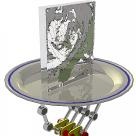MARS is ECMWF's Meteorological Archival and Retrieval System. This documentation focuses on facilities for the retrieval of data from ECMWF's operational and other archives, including the online Fields Data Base (FDB).
There are a number of factors differentiating MARS from other Archive systems around the world:
- Facilities to Archive and Retrieve meteorological data, enabling very easy access to the Archives via a pseudo-meteorological language
- Different requirements imposed by ECMWF's Operational and Research environments. They force MARS to be a 24 hour service with as very little down-time as possible
- Batch and interactive modes have to be supported
- Large amount of data, both in size and number of items stored
- Large number of users with different requirements. Some users retrieve large datasets rarely, whereas others retrieve few fields very often.
- Heterogeneous environment, involving Supercomputers, user workstations and remote systems all interconnected with a variety of network technology
- MARS holds Petabytes of data, mainly using GRIB format for Meteorological fields and BUFR format for Meteorological Observations. Most of the data produced at ECMWF daily is archived in MARS, and therefore available to users.
eLearning modules providing an introduction to MARS
This documentation starts with an overview of ECMWF's activity, as it is necessary to know the kind of data available from a meteorological archive. In section MARS content the most common products are listed, followed by details on the data formats used.
Section Web-MARS gives an overview on Web-MARS, the Web interface to MARS, which is not only the best documentation of the archive content but also a useful tool when retrieving data.
Section MARS command and request syntax follows with a description of the MARS command and explains the pseudo-meteorological vocabulary, i.e. the MARS language. It introduces the MARS request format and syntax. Then, it focuses on the structure of retrieve requests. Keywords in MARS and Dissemination requests lists keywords relevant to data retrieval and the most common products are reviewed, providing the MARS terms needed to name each data set.
Later on, the MARS architecture is described: what are the clients and servers. This enables users to understand the request execution of a MARS request: what is happening behind the scenes from the user's point of view.
Within all the above concepts, section Retrieve focuses on aspects to bear in mind while retrieving data from MARS, e.g. request scheduling in the main archive, post-processing capabilities available, hints to maximise retrieval efficiency and trouble shooting guidelines.
The following sections explain how to list archived data (section List) and how to carry out computations in MARS
The remaining part presents a selection of example requests and answers to some Frequently Asked Questions (FAQ)
- MARS quick start
- MARS content
- Web-MARS
- MARS command and request syntax
- MARS architecture
- MARS actions
- Keywords in MARS and Dissemination requests
- MARS example requests
- MS computing training courses
- Guidelines to write efficient MARS requests
- MARS FAQ
- MARS interpolation with MIR
- Why am I getting the following MARS message: The efficiency of your requests in the last 12 hours is
